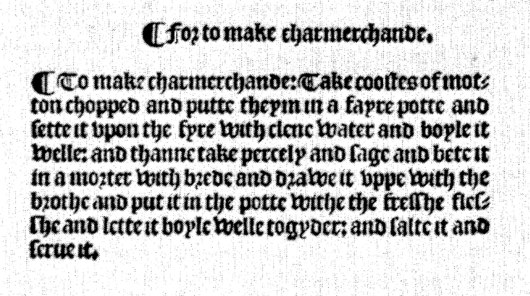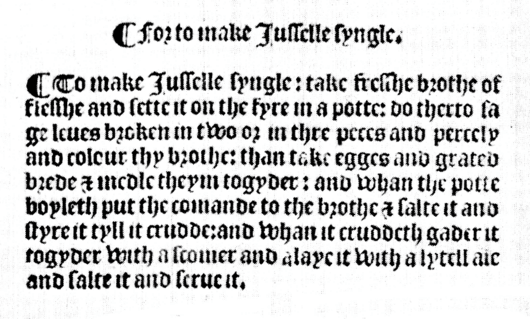The Boke of Cokery facts for kids
This Is the Boke of Cokery, also known as The Boke of Cokery, is thought to be the very first cookbook ever printed in English. We don't know who wrote it. It was printed by a man named Richard Pynson in the year 1500.
This book was quite popular for many years in the 1500s. However, it was later forgotten by the 1700s. Today, only one copy of this special book is known to exist. It is kept at Longleat House in Wiltshire, England.
Contents
The Start of Cookbooks in Print
Cookbooks were not a new idea in England by the early 1500s. People had been writing down recipes for a long time. For example, the British Library has a handwritten cookbook from around 1440. This older book was called A Boke of Kokery.
These handwritten books were very expensive and rare. Not many people could own them. Things changed when printing presses arrived. William Caxton brought printing to England in 1476. But he didn't print any cookbooks.
That changed nine years after Caxton died. Richard Pynson printed This Is the Boke of Cokery. This made cookbooks available to more people.
Where and When It Was Printed
The book was "emprynted without temple barre by Rycharde Pynson in the yere of our lorde MD". This means it was printed near Temple Bar in London in the year 1500. The book has 124 pages, but they are not numbered.
The first sentence of the book tells you its purpose:
This means it was a book about royal feasts and cooking. It was meant for a prince's home or other important people.
What's Inside the Book
The historian Stephen Mennell says the book feels very "medieval." It mostly focuses on big banquets for rich families. Cookbooks didn't start giving everyday recipes until later in the 1500s.
The book shares details about many old royal feasts. It uses information from an even older recipe book. This older book is now at Holkham Hall in Norfolk.
A Royal Feast Example
One example is a feast given by King Henry the Fourth. This feast was for men from Hainaut and France. They had just finished a jousting tournament in Smythefelde.
The feast had three courses. It included fancy game and meats. Some dishes were:
- "Creme of Almondes" (almond cream)
- Larks
- Stewed potage (a type of stew)
- Roasted venison and partridge
- Quail and egret (a type of bird)
- Rabbits and plovers (another type of bird)
- "Pomerynges" (possibly apple dishes)
- "Leache of brauwne wyth batters" (a sliced meat dish with batter)
A Grand Archbishop's Dinner
The book also describes a huge feast. This was for the Archbishop of York when he started his new role in 1465. Sixty-two cooks worked to prepare this amazing meal!
Big birds were served with their feathers still on. Peacocks were even served with their tails spread out. One of the drinks was "ipocrasse," which was a spiced wine.
Here's how to make "ipocrasse" from the book:
This recipe tells you to crush spices like cinnamon, ginger, and cardamom. Then you mix them with red wine and sugar. Finally, you strain the wine through a cloth.
Unique Old Recipes
The book has many recipes for dishes we don't eat much today. Some examples are:
- "Comyne": A dish made with almond milk, cumin spice, and eggs.
- "Jusselle": A meat broth mixed with ale.
- "Buknade": A dish made with veal and eggs.
- "Charmerchande": A mutton stew with sage and parsley, made thick with breadcrumbs.
The Book's Journey Through Time
In 1595, a book seller named Andrew Maunsell mentioned This Is the Boke of Cokery. He noted it was still being sold in the 1530s. Back then, it was sometimes called A noble boke of festes royall and of Cookerie for Princes housholde.
For many years, Pynson's book was the main cookbook available. Another printer, Wynkyn de Worde, released The Boke of Kervynge in 1508. This book was about how to carve and serve food at feasts. It wasn't about cooking the food itself.
A new cookbook didn't appear until the 1540s. This was A Proper Newe Booke of Cokerye (1545). Pynson's original book was mostly forgotten by the 1700s. In 1810, a writer named Thomas Dibdin wondered if any copies still existed.
The Only Copy Found
In 1954, the only known copy of the book was found. It was in the library at Longleat. This special copy was lent for an exhibition in London. The exhibition celebrated the end of wartime food rationing. It showed cookbooks from over 450 years of history.



